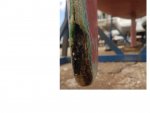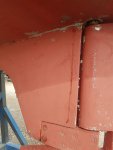sailoppopotamus
Well-Known Member
Two days before I was due to haul out my boat, my mooring line failed. The boat was med-moored stern-to and was blown stern-first onto the dock, with the rudder catching on a submerged rock right next to the dock. Thankfully it was only blowing a little over ten knots, and this was quickly noticed by people in the marina who managed to tie my boat onto a neighbouring boat until I could get to it and move it to another spot. I hauled the boat out 48 hours later, to find that the rudder has indeed suffered some damage. I've attached pictures of this. The gash seems to be 10-15cm long, at the bottom of the trailing edge of the rudder.
Mechanically, the rudder seems fine -- there's hardly any play, it moves from end to end without resistance, and I had no problems maneuvering the boat from where it was docked to where it was picked up by the crane.
My questions are the following:




Mechanically, the rudder seems fine -- there's hardly any play, it moves from end to end without resistance, and I had no problems maneuvering the boat from where it was docked to where it was picked up by the crane.
My questions are the following:
- Does it seem like this could be repaired in place, or will I have to remove the rudder? Unfortunately I'm not allowed to dig a hole under the rudder so it will be quite expensive if I had to remove it.
- Do I have to wait for it to dry before it can be repaired? How long? The rudder stayed in the water for 48 hours in this state. How will I know when it's dry? I'm quite keen to get the boat in the water as quickly as possible, but know I can't rush this.
- How worried should I be about the water dribbling out from the hole that houses the bearing? People in the marina told me that all boats do this when hauled out (the photo was taken 24 hours after haul out).





